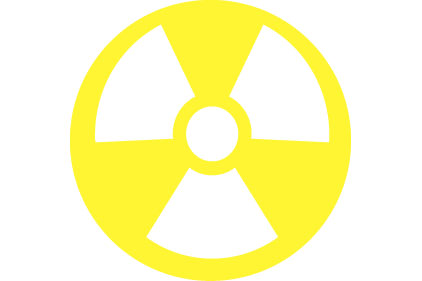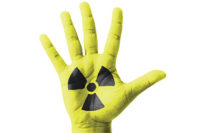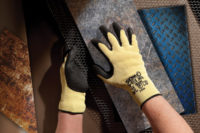The kind of radiation discussed in this article is called ionizing radiation because it can produce charged particles (ions) in matter.
|
" Radiation does not spread or get “on” or “in” people; rather, it is radioactive
contamination that can be spread. "
|
Ionizing radiation is produced by unstable atoms. Unstable atoms differ from stable atoms because unstable atoms have an excess of energy or mass or both. Radiation can also be produced by high-voltage devices (e.g., x-ray machines).
Atoms with unstable nuclei are said to be radioactive. In order to reach stability, these atoms give off, or emit, the excess energy or mass. These emissions are called radiation. The kinds of radiation are electromagnetic (like light) and particulate (i.e., mass given off with the energy of motion). Gamma radiation and x-rays are examples of electromagnetic radiation. Gamma radiation originates in the nucleus while x-rays come from the electronic part of the atom. Beta and alpha radiation are examples of particulate radiation.
Interestingly, there is a “background” of natural radiation everywhere (ubiquitous) in our environment. Ubiquitous background radiation comes from space (i.e., cosmic rays) and from naturally occurring radioactive materials contained in the earth and in living things.
What is radioactive contamination?
If radioactive material is not in a sealed source container, it might be spread onto other objects. Contamination occurs when material that contains radioactive atoms is deposited on materials, skin, clothing or anyplace where it is not desired. It is important to remember that radiation does not spread or get “on” or “in” people; rather, it is radioactive contamination that can be spread. A person contaminated with radioactive material will receive radiation exposure until the source of radiation (the radioactive material) is removed.
- A person is externally contaminated if radioactive material is on the skin or clothing.
- A person is internally contaminated if radioactive material is breathed in, swallowed or absorbed through wounds.
- The environment is contaminated if radioactive material is spread about or is unconfined.
How can you work safely around radiation?
You can work safely around radiation and/or contamination by following a few simple precautions:
1. Use time, distance, shielding and containment to reduce exposure.
2. Wear dosimeters (e.g., film or TLD badges) if issued.
3. Avoid contact with the contamination.
4. Wear protective clothing that, if contaminated, can be removed.
5. Wash with nonabrasive soap and water any part of the body that may have come in contact with the contamination.
6. Assume that all materials, equipment and personnel that came in contact with the contamination are contaminated. Radiological monitoring is recommended before leaving the scene.
Measuring occupational exposures
Although some radiation exposure is natural in our environment, it is desirable to keep radiation exposure as low as reasonably achievable (ALARA) in an occupational setting. This is accomplished by the techniques of time, distance, and shielding.
Time: The shorter the time in a radiation field, the less the radiation exposure you will receive. Work quickly and efficiently. Plan your work before entering the radiation field.
Distance: The farther a person is from a source of radiation, the lower the radiation dose. Levels decrease by a factor of the square of the distance. Do not touch radioactive materials. Use remote handling devices, etc., to move materials to avoid physical contact.
Shielding: Placing a radioactive source behind a massive object provides a barrier that can reduce radiation exposure.
Administrative and Engineering Controls: The use of administrative and engineering controls is essential for keeping radiation exposure ALARA.
Monitoring occupational radiation exposure is a fundamental aspect of radiation protection. This can be done by measuring radiation fields with a common handheld instrument such as a Geiger-Mueller counter and, if exposure conditions are predictable and relatively low (i.e., less than 10 percent of the regulatory limit), expected exposures can be calculated and documented. Alternately, regular radiation field survey measurements can be performed, and personnel dosimeters are issued to workers.
Film Badge: A film badge is one of the earliest devices used to measure worker exposure to gamma radiation from radium and x rays. Initially packets of dental x-ray film were worn and developed periodically to view the degree of darkening. Later special metal filters were used in an x-ray film holder, with an open window to provide unattenuated film area for high-energy beta measurement. With appropriate calibration of exposure versus optical density, these devices provide an accurate measure of worker external exposure and a permanent record.
Thermoluminescent Dosimeter (TLD) Badge: The TLD badge is a personnel monitoring device with special chemical compounds (e.g., lithium fluoride) in powder of solid form that retain deposited energy from radiation exposure. These TL materials emit light when subsequently heated in a reader. The light is detected by a PMT, and through calibration the electrical current provides a proportional measure of radiation exposure. However once read out, the signal from these devices is erased for the most part. Thus, quality control on measurements must be to the strictest standards. The National Institute of Standards and Technology (NIST) has developed a national voluntary laboratory accreditation program (NAVLAP) for all external dosimetry (e.g., film, TLD) processors. Cross-checks, reviewed procedures, on-site inspections, etc., all provide assurance that dosimeter results are of the highest quality.
Optically Stimulated Luminescence (OSL) Badge: The OSL dosimeter/reader technology is relatively new and uses a laser to stimulate an aluminum oxide material that was in the badge for personnel radiation monitoring of occupationally exposed workers. With optically stimulated luminescence, a tiny crystal traps and stores energy from exposure to ionizing radiation fields. The amount of exposure can be determined by shining a green light on the crystal and measuring the intensity of the blue light emitted. OSL systems allow instantaneous readings that can be repeated, as opposed to TLDs which take 20 or 30 seconds for a one-time-only reading.
Pocket Ionization (Ion) Chamber: This is a sealed cylindrical air-filled chamber, sometimes called a direct reading dosimeter (DRD) or quartz fiber dosimeter (QFD), with a charged quartz fiber that can be directly viewed through a built-in microscope. This filament can be seen against a scale from typically 0 to 200 milliroentgen or 0 to 5 R. Ionizing gamma radiation passing through the chamber causes a discharge of the device and a deflection of the fiber upscale. When properly manufactured, maintained, and calibrated, these devices provide a fairly accurate direct measure of external exposure. In the late 1980s a thin-walled type was introduced that was more sensitive to diagnostic-energy x-rays. The advantage of these DRDs or QFDs is instantaneous indication of radiation exposure. However, they are fragile devices and subject to leakage. Frequent calibration and leakage checks are recommended, as well as the use of two dosimeters side by side. Readings that do not reasonably match should be suspect.
Electronic Dosimeters: Electronic dosimeters have been available since the early 1980s. These devices use energy-compensated Geiger-Mueller tubes or solid-state detectors with supporting electronics in a package typically the size of a deck of playing cards. Features vary with respect to size, ruggedness, user control, display of accumulated dose and/or dose rate, alarm set point, battery life, computer interface, etc.
Reprinted with permission from the Health Physics Society.







